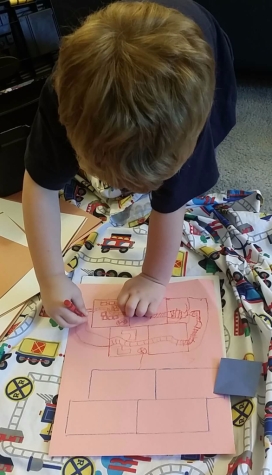Learning About Tessellations
This week in our spontaneous preschool* math adventures we’ve encountered tessellations, patterns, observations, arts and crafts, and dragons. (*Almost everything explained here could easily be duplicated with students of all ages; in fact, older students would be able to better understand and experiment with these ideas.)

N loves this train bedsheet set that we bought him way back when he moved up to his toddler bed. The other night, as he was tracing the train tracks on it with a little toy car (or maybe one of his Paw Patrol toys?) he shouted out from his bedroom, “Why do the train tracks never end?”
I love these moments when I realize my son thinks about things the same way I did as a kid. 🙂 I remember tracing out repeating patterns on sheets or fabric rolls and trying to find the original square of print that kept repeating endlessly. I was always fascinated by the way that someone could design a pattern with loops and lines that connected to repeating tiled patterns in such a smooth way that you couldn’t find the original “block” of pattern.
Observations
The next morning I asked him to bring out his sheet to the living room and we spread it out flat on the floor and set up two observation chairs (one chair for ‘lil dude, The Destroyer, who wants to do everything Big Brother is doing). Then we sat and observed as many details as we could think of. We talked about all kinds of colors and shapes and then he started realizing that some of the trains and shapes were all over the place, and the more we pointed out repeating pieces, the more he realized it was all one big repeating pattern. I tried to show him my thought process of tracing out a block of pattern that repeated, but I think that was a bit too complex for him at this point. Older kids could probably understand that part better.
Which shapes tessellate?
Then I brought out the craft supplies and cut out a circle, square, and rectangle from construction paper. He helped me trace each one several times to see what the pattern would look like. I asked him what was different about the repeating circles and the repeating squares/rectangles designs. He had a lot of random thoughts on the topic, but eventually mentioned that there are empty spaces between the circles but not between the squares and rectangles. He got it! 🙂



The shapes that can be copied endlessly, filling a sheet with no gaps or spaces between the shapes, are called tessellations. A lot of art, as well as naturally occurring phenomena, are based on tessellations. (I might do another post on this later, because it’s really amazing stuff!) Here’s a good link I found to a simple, fun lesson on tessellations: https://www.mathsisfun.com/geometry/tessellation.html.
Within that “block” that tessellates, graphic designers can create a picture that will connect at various points to itself when it is copied and repeated endlessly so that the overall picture looks like one large never-ending design. We briefly practiced drawing up something like this. He had fun with it, but the accuracy element was definitely above his skill level.



Creating our own tessellations
Next I showed him how some artists make incredibly detailed patterns that tessellate by starting with a simple shape. If you start with a rectangle, cut out a shape from one side, and tape it to the opposite side, it will form an interlocking shape that will still fill a sheet (a plane, technically) with no gaps. You can use this idea to make something as fancy and complex as you like. (He really just wanted to make a dragon, though, which is not a tessellating shape, for the record.)



We finished up with a google image search for “tessellations in art” and “tessellations in nature.” At this point, it was all just a fun introduction to a complex topic; I think older kids could get a lot more out of this. Even at a young age, however, kids can have fun exploring mathematical topics, and the more they see ways that math appears in nature and art, the more likely they’ll be to enjoy learning math in the future.
Here’s an example of a famous tessellation by M.C. Escher (picture from this website: https://www.tes.com/lessons/iez-dWediUSu6w/mc-escher-tessellations-various-artwork)

Have your kids (in your home or classroom) done any fun art projects based on math? I’d love to see more ideas on this theme!
Other Math Monday posts:
- Ten-frame math with seashells
- Cotton Ball Algebra
- Sticker Bar Graphs
- RightStart curriculum
- Exponential Growth (for kids)
Teaching and Learning Products
To see my series of activity-based lesson packs and other learning resources (Pre-K – 12th grade), visit my store at: https://www.teacherspayteachers.com/Store/Sandra-Balisky




2 comments on “Math Monday: Tessellations”